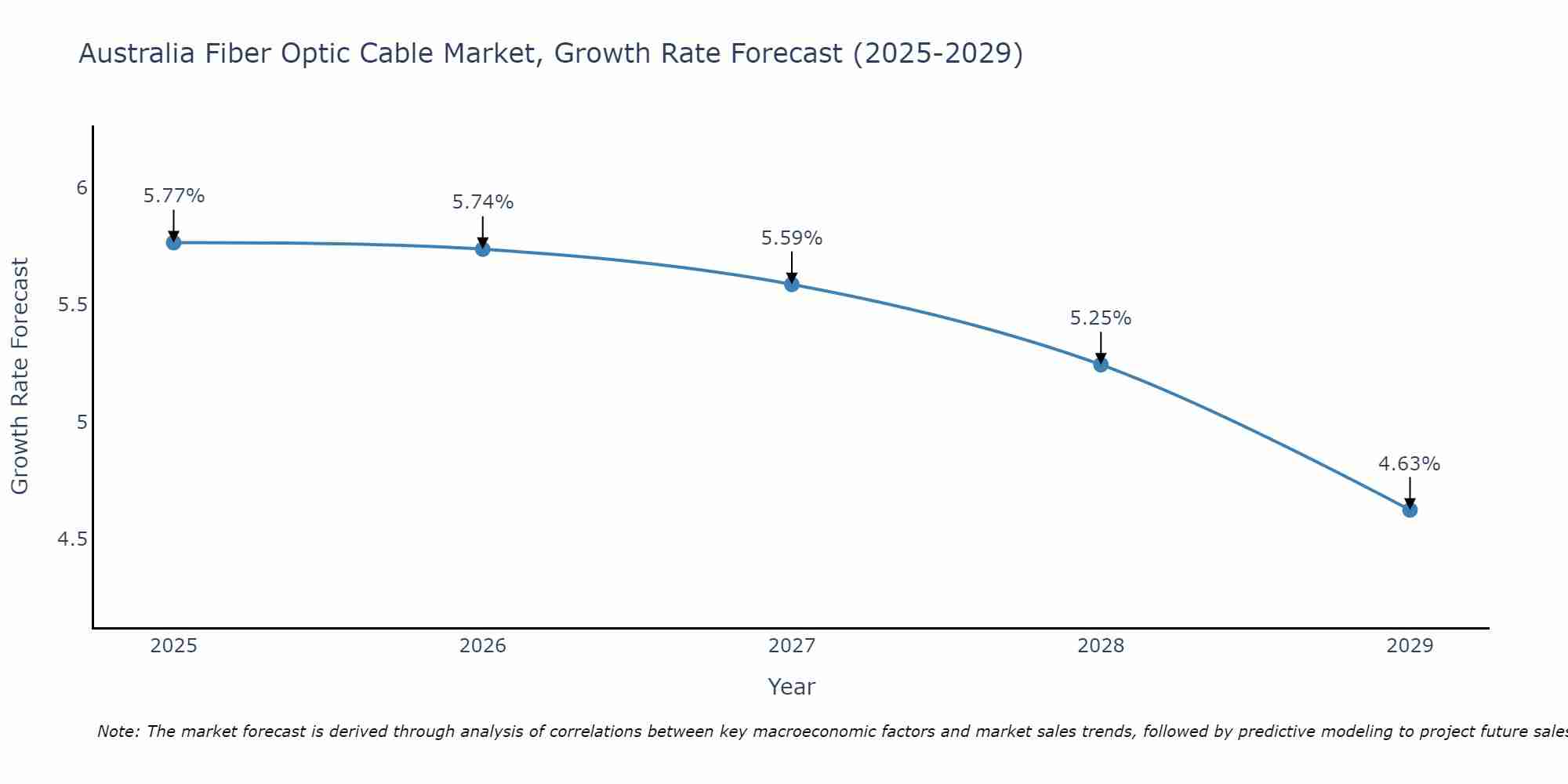Australia Fiber Optic Cable Market Outlook | Share, Companies, Forecast, COVID-19 IMPACT, Growth, Size, Value, Analysis, Industry, Revenue & Trends
| Product Code: ETC363995 | Publication Date: Aug 2022 | Updated Date: Apr 2025 | Product Type: Market Research Report | |
| Publisher: 6Wresearch | Author: Shubham Padhi | No. of Pages: 75 | No. of Figures: 35 | No. of Tables: 20 |
Australia Fiber Optic Cable Market Size Growth Rate
The Australia Fiber Optic Cable Market may undergo a gradual slowdown in growth rates between 2025 and 2029. Beginning strongly at 5.77% in 2025, growth softens to 4.63% in 2029.

Australia Fiber Optic Cable Market Overview
The Australia fiber optic cable market is experiencing robust growth driven by increasing demand for high-speed internet connectivity, digitalization initiatives across various sectors, and the expansion of telecommunications infrastructure. Fiber optic cables offer superior bandwidth, faster data transmission speeds, and immunity to electromagnetic interference compared to traditional copper cables, making them ideal for supporting broadband internet, telecommunication networks, and data centers in Australia.
Drivers of the market
One of the primary drivers of the Australia fiber optic cable market is the increasing demand for high-speed and reliable internet connectivity. Fiber optic cables offer superior bandwidth and data transmission capabilities compared to traditional copper cables, making them essential for delivering high-speed internet services to residential, commercial, and industrial users. The growing adoption of bandwidth-intensive applications such as video streaming, cloud computing, online gaming, and telecommuting drives the need for robust fiber optic infrastructure across Australia. Additionally, government initiatives aimed at expanding broadband coverage and improving digital connectivity further stimulate the demand for fiber optic cables in the country.
Challenges of the market
One of the key challenges in the Australia fiber optic cable market is the high initial investment required for infrastructure development. Installing fiber optic cables involves significant capital expenditure for laying down the network infrastructure, including cables, conduits, and related equipment. Additionally, the need for skilled labor and specialized expertise for installation and maintenance further adds to the costs. Moreover, regulatory hurdles, such as obtaining permits and rights-of-way, can also delay project timelines and increase operational expenses.
Government Policy of the market
In the fiber optic cable market, government policies focus on supporting the deployment of high-speed broadband networks across the country. Initiatives such as the National Broadband Network (NBN) receive government funding and regulatory support to ensure widespread access to reliable and high-quality internet connectivity. These policies drive demand for fiber optic cables and encourage investment in advanced telecommunications infrastructure.
Key Highlights of the Report:
- Australia Fiber Optic Cable Market Outlook
- Market Size of Australia Fiber Optic Cable Market, 2024
- Forecast of Australia Fiber Optic Cable Market, 2031
- Historical Data and Forecast of Australia Fiber Optic Cable Revenues & Volume for the Period 2018 - 2031
- Australia Fiber Optic Cable Market Trend Evolution
- Australia Fiber Optic Cable Market Drivers and Challenges
- Australia Fiber Optic Cable Price Trends
- Australia Fiber Optic Cable Porter's Five Forces
- Australia Fiber Optic Cable Industry Life Cycle
- Historical Data and Forecast of Australia Fiber Optic Cable Market Revenues & Volume By Cable Type for the Period 2018 - 2031
- Historical Data and Forecast of Australia Fiber Optic Cable Market Revenues & Volume By Single-Mode for the Period 2018 - 2031
- Historical Data and Forecast of Australia Fiber Optic Cable Market Revenues & Volume By Multi-Mode for the Period 2018 - 2031
- Historical Data and Forecast of Australia Fiber Optic Cable Market Revenues & Volume By Material for the Period 2018 - 2031
- Historical Data and Forecast of Australia Fiber Optic Cable Market Revenues & Volume By Glass for the Period 2018 - 2031
- Historical Data and Forecast of Australia Fiber Optic Cable Market Revenues & Volume By Plastic for the Period 2018 - 2031
- Historical Data and Forecast of Australia Fiber Optic Cable Market Revenues & Volume By Application for the Period 2018 - 2031
- Historical Data and Forecast of Australia Fiber Optic Cable Market Revenues & Volume By Communication for the Period 2018 - 2031
- Historical Data and Forecast of Australia Fiber Optic Cable Market Revenues & Volume By Power Transmission for the Period 2018 - 2031
- Historical Data and Forecast of Australia Fiber Optic Cable Market Revenues & Volume By Sensor for the Period 2018 - 2031
- Historical Data and Forecast of Australia Fiber Optic Cable Market Revenues & Volume By Others for the Period 2018 - 2031
- Australia Fiber Optic Cable Import Export Trade Statistics
- Market Opportunity Assessment By Cable Type
- Market Opportunity Assessment By Material
- Market Opportunity Assessment By Application
- Australia Fiber Optic Cable Top Companies Market Share
- Australia Fiber Optic Cable Competitive Benchmarking By Technical and Operational Parameters
- Australia Fiber Optic Cable Company Profiles
- Australia Fiber Optic Cable Key Strategic Recommendations
Frequently Asked Questions About the Market Study (FAQs):
- Single User License$ 1,995
- Department License$ 2,400
- Site License$ 3,120
- Global License$ 3,795
Search
Related Reports
- Portugal Electronic Document Management Market (2025-2031) | Strategy, Consumer Insights, Analysis, Investment Trends, Opportunities, Growth, Size, Share, Industry, Revenue, Segments, Value, Segmentation, Supply, Forecast, Restraints, Outlook, Competition, Drivers, Trends, Demand, Pricing Analysis, Competitive, Strategic Insights, Companies, Challenges
- France Electronic Document Management Market (2025-2031) | Strategy, Consumer Insights, Analysis, Investment Trends, Opportunities, Growth, Size, Share, Industry, Revenue, Segments, Value, Segmentation, Supply, Forecast, Restraints, Outlook, Competition, Drivers, Trends, Demand, Pricing Analysis, Competitive, Strategic Insights, Companies, Challenges
- Portugal Occupational Health & Safety Services Market (2025-2031) | Strategy, Consumer Insights, Analysis, Investment Trends, Opportunities, Growth, Size, Share, Industry, Revenue, Segments, Value, Segmentation, Supply, Forecast, Restraints, Outlook, Competition, Drivers, Trends, Demand, Pricing Analysis, Competitive, Strategic Insights, Companies, Challenges
- Netherlands Occupational Health and Safety Services Market (2025-2031) | Strategy, Consumer Insights, Analysis, Investment Trends, Opportunities, Growth, Size, Share, Industry, Revenue, Segments, Value, Segmentation, Supply, Forecast, Restraints, Outlook, Competition, Drivers, Trends, Demand, Pricing Analysis, Competitive, Strategic Insights, Companies, Challenges
- Belgium and Luxembourg Facility Management Market (2025-2031) | Strategy, Consumer Insights, Analysis, Investment Trends, Opportunities, Growth, Size, Share, Industry, Revenue, Segments, Value, Segmentation, Supply, Forecast, Restraints, Outlook, Competition, Drivers, Trends, Demand, Pricing Analysis, Competitive, Strategic Insights, Companies, Challenges
- Russia Women Intimate Apparel Market (2025-2031) | Strategy, Consumer Insights, Analysis, Investment Trends, Opportunities, Growth, Size, Share, Industry, Revenue, Segments, Value, Segmentation, Supply, Forecast, Restraints, Outlook, Competition, Drivers, Trends, Demand, Pricing Analysis, Competitive, Strategic Insights, Companies, Challenges
- Africa Chocolate Market (2025-2031) | Size, Share, Trends, Growth, Revenue, Analysis, Forecast, industry & Outlook
- Global Hydroxychloroquine And Chloroquine Market (2025-2031) | Industry, Trends, Size, Outlook, Growth, Value, Companies, Revenue, Analysis, Share, Forecast
- Saudi Arabia Plant Maintenance Market (2025-2031) | Industry, Size, Growth, Revenue, Value, Companies, Forecast, Analysis, Share & Trends
- Taiwan Electric Truck Market (2025-2031) | Outlook, Industry, Revenue, Size, Forecast, Growth, Analysis, Share, Companies, Value & Trends
Industry Events and Analyst Meet
Our Clients
Whitepaper
- Middle East & Africa Commercial Security Market Click here to view more.
- Middle East & Africa Fire Safety Systems & Equipment Market Click here to view more.
- GCC Drone Market Click here to view more.
- Middle East Lighting Fixture Market Click here to view more.
- GCC Physical & Perimeter Security Market Click here to view more.
6WResearch In News
- Doha a strategic location for EV manufacturing hub: IPA Qatar
- Demand for luxury TVs surging in the GCC, says Samsung
- Empowering Growth: The Thriving Journey of Bangladesh’s Cable Industry
- Demand for luxury TVs surging in the GCC, says Samsung
- Video call with a traditional healer? Once unthinkable, it’s now common in South Africa
- Intelligent Buildings To Smooth GCC’s Path To Net Zero













